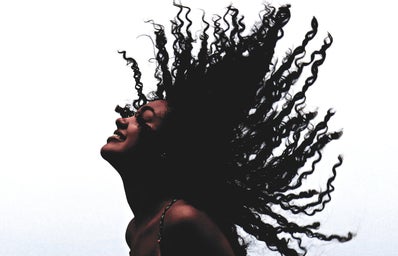My childhood consisted of my mother and I trying to wrangle my unruly hair into an acceptable position. At some point, my hair started to curl into the underneath layers, and we had no idea what to do with it. In middle school, my mom finally introduced me to my savior and greatest enemy: a straightener.
I started to religiously straighten my hair for years on end. Especially as a swimmer, who had her hair in chlorine for hours a day, this combination racked up a lot of damage. It wasn’t until my senior year that a hairdresser finally asked me if I realized I had curly hair. I did have an inkling, but I honestly thought this was just how my hair was. COVID happened shortly after, which is where I started my curly hair journey.
After a lot of testing and tutorials, I eventually found a hair care routine for different styling days depending on what curls I wanted. Although I still struggle with not putting heat on my hair, I have started to start loving my curls, and I hope after reading this, you can start to love and manage your curls a little bit more too!
Embarking on a journey to embrace and care for your natural curls requires an understanding of your unique hair type. To begin this, start by identifying whether your hair is wavy, curly, or coiled, as this distinction will guide your product choices and styling techniques.
For individuals with wavy hair characterized by gentle waves but no tight coils, opt for lightweight products such as mousse or light gels. These products help define waves without weighing down the hair. If your hair is damaged by coloring and heat like mine, your curls might be wavy at first. Beginning products I recommend are multi miracle leave-in conditioner by RAWsugar, OUAI curl creme, and Not Your Mother’s Curl Talk gel.
If your hair showcases noticeable curls and coils throughout, indicating a curly hair type, you can explore slightly heavier products like curl creams and max hold gels. Be cautious about using overly heavy butters or oils, as they may weigh down your curls. Recommended products for curly hair include Shea Moisture Coconut and Hibiscus FrizzFree Curl mousse, and Kinky-Curly original Curling Custard Styling Gel. I would also recommend experimenting with some souffles. Products like the Curl Smith Styling Souffle and Mielle curl Souffle offer the definition of a gel without as strong of a cast.
For those with tight coils throughout the hair, coiled hair types benefit from the use of butter and oils to maintain moisture and definition. Camille Rose Naturals Curlaide Moisture Butter is a popular choice in this category, as well as the majority of the Shea Moisture line.
When it comes to styling, it’s essential to be mindful of heat usage. Limit the application of heat styling tools like straighteners and curling irons to prevent permanent damage. If blow-drying, use a diffuser attachment and set the dryer to low or medium heat. Make sure you start with 5-10 minutes of lightly diffusing around your head to dry your gel cast. Afterwards, flip your hair upside down and massage your diffuser into your roots, then capture your curls in the diffuser and push up into your roots.
Avoid the temptation to wash your curly hair every day, as this can strip away natural oils essential for curl health. Instead, extend the time between washes and consider incorporating an evening scalp massage with hair oil to promote overall scalp health. Volumizing dry shampoo can be used to help stretch the time between washes. One of my holy grails is Batiste dry shampoo. Although, be careful with the amount you use, especially if your hair is more kinky.
To maintain healthy curls, eliminate products containing sulfates, parabens, and silicones from your routine. These ingredients can be harmful to curly hair, causing dryness and build-up. Opt for sulfate-free shampoos and products without parabens or silicones. Additionally, no matter what curl type you have, oiling your hair is essential to make sure it is hydrated enough. Any type of coconut, argan, or jojoba oil has amazing benefits for your hair and nail growth.
Incorporating a weekly deep conditioning treatment is vital, especially for those who have experienced heat damage or used products with harmful ingredients. Shea Moisture Repair And Restore and Mixed Chicks Deep Conditioning Treatment are recommended for this purpose. Another great tip for managing and upkeep healthy curly hair is a fear of mine I had to get over– receiving regular haircuts about every 4-6 weeks. Regular trims are crucial for maintaining healthy curls, preventing split ends and breakage. Despite the desire for length, prioritizing the health of your curls through regular trims is essential!
In conclusion, starting a curly hair routine is a journey that requires patience and understanding. By identifying your hair type, choosing the right products, and adopting healthy habits, you can embark on a transformative experience that celebrates the beauty of your natural curls. Know that your curls are beautiful no matter what type and texture. You don’t have to be the norm to feel beautiful!


